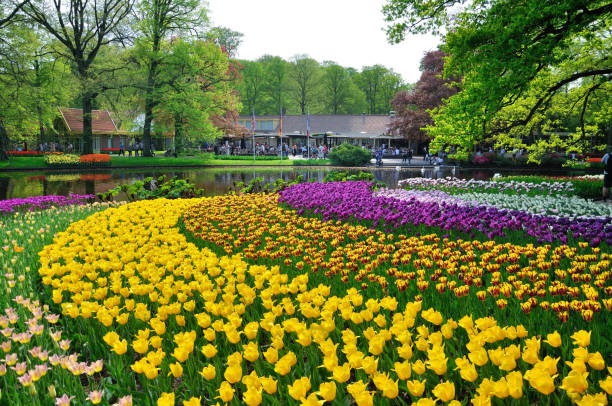As a lover of flowers and their captivating beauty, I invite you to embark on a journey through 15 harmonious flowers starting with H. In this post, we will explore a diverse array of floral wonders that possess the power to evoke tranquility and enchantment.
Have you ever wondered which flowers can bring harmony to your garden or fill your living space with a soothing aura? Which blossoms are key to creating a serene atmosphere that resonates with your soul? We will answer these questions as we delve into the realm of harmonious flowers.
Prepare to be mesmerized by the Hibiscus’s elegant grace and the Hydrangea’s delicate allure. Discover the Hellebore, a flower that emerges as a symbol of hope during the colder months, and the towering beauty of the Hollyhock that can instantly elevate any landscape.
But our exploration continues. We will uncover Heather’s captivating secrets, Hyacinth’s fragrant petals, and Heliotrope’s hypnotic essence. We will unravel each flower’s unique qualities that make them truly harmonious.
The urgency of finding solace and tranquility in our lives compels us to seek the power of nature’s gifts. By understanding the harmonious nature of these flowers, we can curate spaces that bring forth a sense of peace and serenity.
Prepare to be captivated by the influential allure of these flowers as we explore their origins, characteristics, and how they can be incorporated into our lives.
Together, let’s unlock the resilient beauty of these 15 harmonious flowers, starting with H, and harness their power to create an oasis of calm in our world.
Why Should I Use Enchanting Flowers Starting With H?
Enchanting flowers starting with H, hold a unique allure that can greatly enhance your life in several ways. Here are compelling reasons why you should consider incorporating these captivating blossoms into your world:
- Serene Atmosphere: The enchanting beauty of flowers like Hibiscus, Hydrangea, and Hellebore can transform any space into a tranquil oasis. Their harmonious presence brings a sense of peace and calm, creating a soothing atmosphere that helps you unwind and find respite from the chaos of everyday life.
- Aesthetically Pleasing: Flowers starting with “H” boast stunning aesthetics, from the vibrant hues of Hollyhocks to Heather’s delicate and colorful petals. Incorporating these enchanting blooms into your surroundings infuses your environment with natural beauty, elevating its visual appeal and creating a captivating ambiance.
- Emotional Well-being: Flowers have a profound impact on our emotions. The enchanting flowers starting with “H” can uplift your spirits, evoke positive emotions, and alleviate stress. Their presence can brighten your mood, promoting a sense of joy, harmony, and overall well-being.
- Symbolic Meaning: Each flower carries its own symbolism and significance. By selecting enchanting flowers starting with “H,” you can align yourself with their unique meanings. For example, the Hibiscus represents beauty and femininity, while the Hydrangea symbolizes gratitude and heartfelt emotions. Incorporating these flowers allows you to express yourself and convey meaningful messages through their language.
- Connecting with Nature: The beauty of nature has a profound impact on our overall happiness and connectedness. Enchanting flowers starting with “H” allows for a deeper connection with the natural world. By nurturing and caring for these blooms, you cultivate a sense of mindfulness, fostering a stronger bond with your environment.
By embracing the enchantment of flowers starting with H, you invite tranquility, beauty, and emotional well-being into your life. These captivating blossoms can transform your surroundings, uplift your spirits, and deepen your connection with the natural world. Embrace their allure and let the enchantment unfold in your life.
1. Hibiscus
Hibiscus, a mesmerizing flowering plant known for its vibrant and showy blossoms, offers an exquisite addition to any garden or landscape. In this informative brief, we will explore the fascinating world of Hibiscus, including ideal growing locations, best planting tips, and provide detailed answers to two frequently asked questions.
Hibiscus plants thrive in warm and tropical climates, making them ideal for regions with ample sunlight and moderate temperatures. These plants are often found in locations such as the Caribbean, Hawaii, and other tropical regions worldwide. However, they can also be successfully grown in containers and brought indoors during colder seasons in areas with cooler climates.
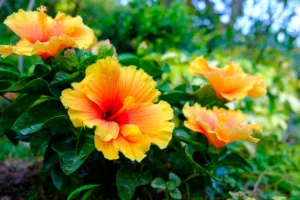
When it comes to planting Hibiscus, there are a few key tips to keep in mind. Firstly, choose a well-draining soil enriched with organic matter to provide the plant with optimal nutrition. The next step is to select a sunny spot in your garden or patio that receives at least six hours of direct sunlight daily. Hibiscus plants thrive in full sun, which helps promote vigorous growth and abundant flowering.
During planting, dig a hole that is slightly larger than the root ball of the Hibiscus plant. Place the plant in the hole, ensuring that the top of the root ball is level with or slightly above the soil surface. Backfill the hole with soil, gently firming it around the plant’s base. Water the newly planted Hibiscus thoroughly and continue to provide regular watering to keep the soil moist but not waterlogged.
FAQs:
Q: How often should I fertilize my Hibiscus plant?
A: Hibiscus plants benefit from regular fertilization during the growing season. Apply a balanced fertilizer, such as a 10-10-10 or 20-20-20 blend, every two to four weeks from spring to early fall. Be sure to follow the package instructions for proper application rates.
Q: How do I prune my Hibiscus plant?
A: Pruning Hibiscus is essential for maintaining its shape and promoting healthy growth. Prune the plant in late winter or early spring before new growth emerges. Remove any dead or damaged branches and any weak or overcrowded stems. Additionally, you can selectively prune to control the plant’s size and encourage branching for a fuller appearance.
Incorporating Hibiscus into your garden or landscape provides a stunning display of colorful blooms and adds a tropical touch to your surroundings. By following the ideal growing locations, planting tips, and addressing common questions, you’ll be on your way to cultivating a thriving and beautiful Hibiscus plant.
2. Hydrangea
Hydrangea, a beloved flowering shrub known for its stunning blooms, offers a captivating addition to any garden or landscape. In this informative brief, we will delve into the world of Hydrangea, including ideal growing locations, best planting tips, and provide detailed answers to two frequently asked questions.
Hydrangeas thrive in moderate climates with ample sunlight and well-drained soil. They are often found in regions with mild summers and winters, making them popular in areas such as the United States, Europe, and Asia. These enchanting flowers starting with H, are known for their ability to add a splash of color and elegance to various landscapes.
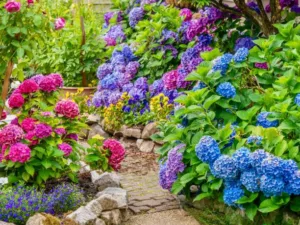
When it comes to planting Hydrangeas, several important factors must be considered. Firstly, select a suitable location that receives partial sun or dappled shade. While some varieties can tolerate full sun, most Hydrangeas prefer protection from the harsh afternoon sun. Additionally, ensure that the soil is well-draining and rich in organic matter.
To plant a Hydrangea, dig a hole that is two times wider and just as deep as the root ball. Gently loosen the roots and place the plant in the hole, ensuring it is at the same level as in the container. Backfill the hole with soil, gently firming it around the plant’s base. Water the newly planted Hydrangea thoroughly to settle the soil.
FAQs:
Q: How do I change the color of my Hydrangea flowers?
A: The color of Hydrangea flowers can be influenced by soil pH. For pink flowers, maintain a slightly acidic to neutral soil (pH 6.0-6.9). For blue flowers, aim for a more acidic soil (pH 5.2-5.5). You can add amendments like aluminum sulfate for blue blooms or lime for pink blooms. Remember that some Hydrangea varieties, like white-flowering ones, do not change color with soil pH.
Q: How do I prune my Hydrangea plant?
A: Pruning Hydrangeas depends on the specific variety. For Hydrangeas that bloom on old wood, such as the macrophylla and serrata types, prune immediately after flowering by removing dead or weak stems. For those that bloom on new wood, such as the paniculata and arborescens types, prune in late winter or early spring before new growth begins. Remove about one-third of the oldest stems to encourage rejuvenation and maintain a more compact shape.
Incorporating Hydrangeas into your garden provides a stunning display of lush foliage and bountiful, colorful blooms. By considering the ideal growing locations, following best planting practices, and addressing common questions, you can successfully cultivate a thriving and visually enchanting Hydrangea plant.
3.Hellebore
Hellebore, an enchanting flowering perennial, is a beloved addition to gardens and landscapes. In this informative brief, we will explore the captivating world of Hellebore, including ideal growing locations, best planting tips, and provide detailed answers to three frequently asked questions.
Hellebores thrive in cool and temperate climates, making them ideal for regions with mild winters and moderate summers. These resilient flowers starting with “H” are often found in woodland gardens, shady borders, and alongside paths where their delicate beauty can be appreciated.
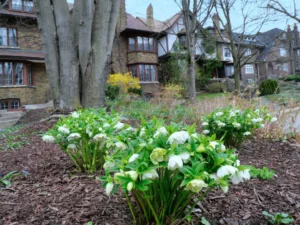
When it comes to planting Hellebores, there are key considerations to ensure their successful growth. Firstly, select a location that provides dappled or partial shade. Hellebores prefer protection from the intense afternoon sun, especially in warmer climates. Additionally, they thrive in well-drained soil that is rich in organic matter. Avoid planting them in heavy clay or waterlogged soil.
To plant Hellebores, dig a hole that is slightly larger than the root ball. Place the plant in the hole, ensuring that the top of the root ball is level with the soil surface. Backfill the hole with soil, gently firming it around the plant’s base. Water the newly planted Hellebore thoroughly to settle the soil.
FAQs:
Q: When do Hellebores bloom?
A: Hellebores typically bloom in late winter to early spring, often providing a much-needed burst of color during the colder months. The exact blooming time can vary depending on the variety and climate. Some Hellebores may begin flowering as early as January, while others may bloom in February or March.
Q: How do I care for Hellebores after they bloom?
A: After the blooming period, it is essential to care for Hellebores to ensure their continued health. Remove any faded or damaged flowers to encourage new growth. Apply a balanced, slow-release fertilizer around the base of the plant in early spring. Additionally, consider providing a layer of mulch to help conserve moisture and suppress weed growth.
Q: Can Hellebores be divided?
A: Hellebores can be divided to propagate new plants or rejuvenate mature ones. The best time to divide Hellebores is in early spring before new growth emerges or in late summer when the weather is cooler. Carefully dig up the plant and divide the root ball into sections, ensuring that each division has healthy roots and foliage. Replant the divisions at the same level as the original plant, water thoroughly, and provide regular care.
Incorporating Hellebores into your garden brings a touch of elegance and beauty, especially during the cooler months. By considering the ideal growing locations, following best planting practices, and addressing common questions, you can cultivate thriving Hellebore plants that grace your landscape with their enchanting blooms.
4. Hollyhock
Hollyhock, a majestic and vibrant flowering plant, adds a touch of elegance and height to gardens and landscapes. In this informative brief, we will explore the captivating world of Hollyhock, including ideal growing locations, best planting tips, and provide detailed answers to two frequently asked questions.
Hollyhocks thrive in areas with full sun and well-drained soil. These tall and stately flowers starting with “H,” are commonly found in cottage gardens, borders, and along fences where they can make a striking statement. They are known for their impressive vertical growth, reaching heights of up to six feet or more.
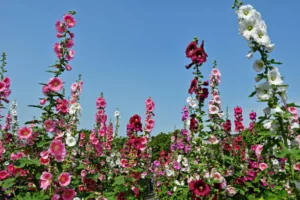
When it comes to planting Hollyhocks, there are a few key considerations for successful growth. Firstly, select a location that receives at least six hours of direct sunlight daily. Hollyhocks thrive in full sun, which promotes vigorous growth and abundant flowering. Additionally, ensure that the soil is well-drained, as excessive moisture can lead to root rot.
To plant Hollyhocks, prepare the soil by removing any weeds and loosening it to a depth of about 12 inches. Sow the seeds directly into the soil in late spring or early summer, spacing them about 18 to 24 inches apart. Cover the seeds with a thin layer of soil and water gently. Keep the soil consistently moist until the seeds germinate, which usually takes about 10 to 14 days.
FAQs:
Q: Do Hollyhocks require staking?
A: Hollyhocks often require staking to support their tall stems and prevent them from bending or toppling over. As the plants grow, insert stakes into the ground behind them and gently tie the stems to the stakes using soft twine or plant ties. This helps maintain their upright form, especially in windy conditions.
Q: How can I prevent diseases in my Hollyhock plants?
A: Hollyhocks can be susceptible to diseases such as rust, which is characterized by orange-brown spots on the leaves. To prevent diseases, ensure proper air circulation by spacing the plants adequately and avoiding overcrowding. Water at the base of the plant to keep the foliage dry. If signs of disease appear, remove and destroy affected leaves to prevent further spread. Applying a fungicide labeled for rust control may also be necessary in severe cases.
Incorporating Hollyhocks into your garden adds vertical interest and a burst of vibrant color. By considering the ideal growing locations, following best planting practices, and addressing common questions, you can cultivate healthy and stunning Hollyhock plants that create a visually enchanting display in your outdoor space.
5. Heather
Heather, a charming flowering plant, adds a touch of elegance and allure to various landscapes. In this informative brief, we will explore the fascinating world of Heather, including ideal growing locations, best planting tips, and provide detailed answers to two frequently asked questions.
Heather thrives in areas with cool climates and acidic soil. These resilient flowers starting with H are commonly found in regions such as Scotland, Ireland, and other parts of Northern Europe. Heather is known for its vibrant colors and delicate foliage, making it a popular choice for rock gardens, borders, and low-maintenance landscapes.
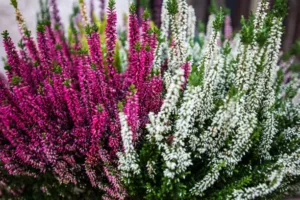
When it comes to planting Heather, there are a few key considerations for successful growth. Firstly, select a location that provides full sun to partial shade. Heather requires at least six hours of sunlight daily to bloom abundantly. Additionally, the soil should be well-drained and acidic, with a pH level between 4.5 and 6.0.
To plant Heather, prepare the soil by removing any weeds and incorporating organic matter such as peat moss or compost to improve drainage and increase acidity. Dig a hole slightly larger than the plant’s root ball. Place the Heather plant in the hole, ensuring that the top of the root ball is level with or slightly above the soil surface. Backfill the hole with soil, gently firming it around the plant’s base. Water the newly planted Heather thoroughly and continue to provide regular watering to keep the soil moist but not waterlogged.
FAQs:
Q: How often should I water Heather plants?
A: Heather plants prefer slightly moist soil. During the growing season, water the plants thoroughly when the top inch of soil feels dry. Avoid overwatering, as waterlogged soil can lead to root rot. Heather may require more frequent watering to prevent dehydration in hot and dry climates.
Q: Do I need to prune Heather plants?
A: Pruning Heather is not always necessary, but it can help maintain a compact and tidy appearance. Prune after flowering by lightly shearing the plant to remove spent flowers and encourage bushier growth. Avoid cutting into old wood, as Heather plants have slow growth and may not recover well from severe pruning.
Incorporating Heather into your garden or landscape adds a touch of charm and vibrant color. By considering the ideal growing locations, following best planting practices, and addressing common questions, you can cultivate healthy and visually enchanting Heather plants that bring beauty to your outdoor space.
6. Hyacinth
Hyacinth, a fragrant and stunning spring flower, brings a burst of color and delightful scent to gardens and landscapes. In this informative brief, we will explore the captivating world of Hyacinth, including ideal growing locations, best planting tips, and provide detailed answers to two frequently asked questions.
Hyacinths thrive in areas with cool climates and well-drained soil. These vibrant flowers starting with H are commonly found in regions with mild winters and moderate summers, such as parts of Europe, North America, and Asia. Hyacinths are highly valued for their intensely fragrant blooms and are often planted in beds, borders, and containers to create visually appealing displays.

When it comes to planting Hyacinths, there are key considerations for successful growth. Firstly, select a location that receives full sun or partial shade. Hyacinths require at least six hours of direct sunlight each day to promote healthy growth and abundant flowering. Additionally, the soil should be well-drained and fertile, preferably with a pH level between 6 and 7.
To plant Hyacinths, prepare the soil by removing any weeds and incorporating organic matter such as compost to improve soil fertility. Dig a hole that is approximately twice the depth of the bulb. Place the bulb in the hole, pointed end facing up, and cover it with soil. Space the bulbs approximately 4 to 6 inches apart. Water the newly planted bulbs thoroughly and provide regular watering during dry periods.
FAQs:
Q: Do Hyacinths need to be lifted and stored after flowering?
A: Hyacinths are hardy perennials and can be left in the ground year-round. However, if you live in an area with extremely cold winters, lifting and storing the bulbs may be necessary. Wait until the foliage turns yellow and withers after blooming, then carefully dig up the bulbs. Clean off any excess soil and allow them to dry in a cool, well-ventilated area. Store the bulbs in a dry location with good airflow until the next planting season.
Q: How can I prevent Hyacinth flowers from flopping over?
A: Flopping or toppling over of Hyacinth flowers can be prevented by providing support. As the flower stalks grow, place stakes or support structures around the plants and gently tie the stalks to keep them upright. This will help prevent bending or breakage, allowing the flowers to be displayed prominently.
Incorporating Hyacinths into your garden or landscape offers a delightful sensory experience with their vibrant colors and captivating fragrance. By considering the ideal growing locations, following best planting practices, and addressing common questions, you can cultivate healthy and visually enchanting Hyacinth plants that bring joy and beauty to your outdoor space.
7. Heliotrope
Heliotrope, a fragrant and charming flower, adds a touch of elegance and allure to gardens and landscapes. In this informative brief, we will explore the captivating world of Heliotrope, including ideal growing locations, best planting tips, and provide detailed answers to two frequently asked questions.
Heliotrope thrives in areas with warm climates and well-drained soil. These enchanting flowers starting with “H” are commonly found in regions with ample sunlight and moderate temperatures, such as the Mediterranean, South America, and parts of Asia. Heliotropes are highly valued for their captivating fragrance and are often planted in beds, borders, and containers to create visually stunning displays.
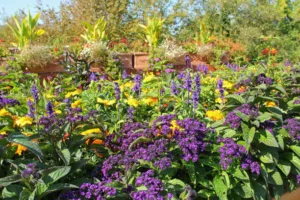
When it comes to planting Heliotrope, there are key considerations for successful growth. Firstly, select a location that receives full sun or partial shade. Heliotropes require at least six hours of direct sunlight daily to promote healthy growth and abundant flowering. Additionally, the soil should be well-drained and fertile, preferably with a pH level between 6 and 7.
To plant Heliotrope, prepare the soil by removing any weeds and incorporating organic matter such as compost to improve soil fertility and moisture retention. Dig a hole approximately the same depth as the plant’s root ball. Place the plant in the hole, ensuring that the top of the root ball is level with or slightly above the soil surface. Backfill the hole with soil, gently firming it around the plant’s base. Water the newly planted Heliotrope thoroughly and provide regular watering to moisten the soil.
FAQs:
Q: How often should I fertilize Heliotrope plants?
A: Heliotropes benefit from regular fertilization during the growing season. Apply a balanced, slow-release fertilizer according to the package instructions. Typically, fertilizing every four to six weeks promotes healthy growth and abundant flowering. Avoid over-fertilizing, as it may result in excessive foliage growth at the expense of flowers.
Q: How do I encourage my Heliotrope plant to produce more fragrance?
A: To enhance the fragrance of your Heliotrope plant, ensure it receives ample sunlight and regular watering. Additionally, deadhead faded flowers by removing them at the base of the stem. This promotes the production of new flower buds and helps redirect the plant’s energy towards fragrance production. Proper care, including adequate nutrition and moisture, will encourage your Heliotrope to release its delightful scent.
Incorporating Heliotrope into your garden or landscape offers a sensory delight with its captivating fragrance and charming appearance. By considering the ideal growing locations, following best planting practices, and addressing common questions, you can cultivate healthy and visually enchanting Heliotrope plants that bring joy and beauty to your outdoor space.
8. Hosta
Hosta, a versatile and lush foliage plant, brings a touch of elegance and beauty to shaded gardens and landscapes. In this informative brief, we will explore the fascinating world of Hosta, including ideal growing locations, best planting tips, and provide detailed answers to two frequently asked questions.
Hostas thrive in areas with partial to full shade, making them excellent choices for gardens with limited direct sunlight. With their broad leaves and vibrant colors, these resilient plants are commonly found in regions with mild climates, such as North America, Europe, and Asia. Hostas are highly valued for foliage and are often planted in beds, borders, and containers to create visually appealing displays.

When it comes to planting Hostas, there are key considerations for successful growth. Firstly, select a location that provides shade or filtered sunlight. Hostas prefer protection from intense sunlight, especially during the hottest parts of the day. Additionally, the soil should be well-drained, fertile, and rich in organic matter.
To plant Hostas, prepare the soil by removing any weeds and incorporating organic matter such as compost or well-rotted manure to improve soil structure and fertility. Dig a hole slightly larger than the plant’s root ball. Place the Hosta in the hole, ensuring that the top of the root ball is level with or slightly above the soil surface. Backfill the hole with soil, gently firming it around the plant’s base. Water the newly planted Hosta thoroughly and provide regular watering to keep the soil consistently moist.
FAQs:
Q: How do I control slugs and snails that damage Hosta leaves?
A: Slugs and snails can be a common problem for Hostas. To control them, implement a few strategies. Firstly, encourage natural predators such as birds, frogs, and toads that feed on these pests. Secondly, create barriers by placing copper tape or crushed eggshells around the base of the plants to deter slugs and snails. Additionally, consider using organic slug pellets sparingly, following the instructions carefully.
Q: When should I divide my Hosta plants?
A: Dividing Hostas is typically done in early spring or fall when the plants are dormant. Dividing helps rejuvenate the plants and maintain their vigor. Dig up the clump and carefully separate the individual plants, ensuring that each division has healthy roots and foliage. Replant the divisions at the same level as the original plant, water thoroughly, and provide regular care.
Incorporating Hostas into your garden or landscape offers a visually appealing display of lush foliage in shaded areas. By considering the ideal growing locations, following best planting practices, and addressing common questions, you can cultivate healthy and vibrant Hosta plants that enhance the beauty of your outdoor space.
9. Heuchera
Heuchera, commonly known as coral bells, is a stunning perennial plant that belongs to the Saxifragaceae family. With its vibrant foliage and delicate flowers, Heuchera has become popular for gardeners seeking to add color and texture to their landscapes. This brief will provide essential information about Heuchera, including ideal growing locations, planting tips, and two frequently asked questions.
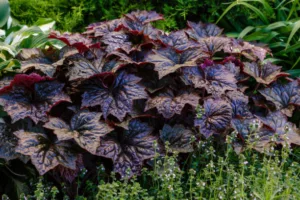
Heuchera thrives in locations that offer a balance of sunlight and shade. It prefers partial shade, especially in regions with hot summers, as excessive heat can cause the leaves to wilt or lose their vibrant color. Well-drained soil is crucial for the plant’s health, as it dislikes wet conditions. This versatile plant can be grown in flower beds, borders, or even containers, making it suitable for various gardening styles and spaces.
When planting Heuchera, choosing a location that matches its growing preferences is important. To improve drainage and fertility, prepare the soil by incorporating organic matter, such as compost. Dig a hole slightly larger than the root ball and place the plant in it, ensuring the crown is leveled with the soil surface. Gently firm the soil around the roots and water thoroughly to settle the plant.
FAQs:
How often should I water Heuchera?
A: Heuchera prefers moderately moist soil, so it is essential to water it regularly. Watering once or twice a week should be sufficient during hot and dry periods. However, it is crucial to avoid overwatering, as excessive moisture can lead to root rot and other fungal diseases.
Does Heuchera produce flowers?
A: Yes, Heuchera does produce flowers, although the flowers are often secondary to the plant’s attractive foliage. The flowers emerge on tall, slender stalks, typically small and bell-shaped. The color of the flowers varies depending on the cultivar, ranging from white and pink to red and coral. While the flowers add an extra touch of beauty to the plant, many gardeners primarily grow Heuchera for its stunning foliage.
In conclusion, Heuchera is a versatile and visually striking perennial plant that adds flair to any garden. Its ideal growing locations include partially shaded areas with well-drained soil. Gardeners can enjoy this remarkable plant’s vibrant foliage and occasional flowers by following proper planting techniques and providing adequate care.
10. Honeysuckle
Honeysuckle, a delightful and fragrant flowering vine, brings beauty and a sweet aroma to gardens and landscapes. In this informative brief, we will explore the captivating world of Honeysuckle, including ideal growing locations, best planting tips, and provide detailed answers to two frequently asked questions.
Honeysuckle thrives in areas with full sun to partial shade, making it a versatile plant suitable for various garden settings. These enchanting flowers starting with “H” are commonly found in regions with moderate climates, including parts of North America, Europe, and Asia. Honeysuckle is highly valued for its fragrant flowers and ability to attract pollinators like hummingbirds and butterflies.
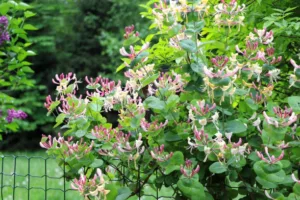
When it comes to planting Honeysuckle, there are key considerations for successful growth. Firstly, select a location that receives at least six hours of direct sunlight daily. While Honeysuckle can tolerate some shade, it blooms best in full sun. Additionally, ensure that the soil is well-drained and fertile, with a pH level between 6 and 7.
To plant Honeysuckle, prepare the soil by removing any weeds and incorporating organic matter such as compost to improve soil structure and fertility. Dig a hole slightly larger than the plant’s root ball. Place the Honeysuckle in the hole, ensuring that the top of the root ball is level with or slightly above the soil surface. Backfill the hole with soil, gently firming it around the plant’s base. Water the newly planted Honeysuckle thoroughly and provide regular watering to moisten the soil.
FAQs:
Q: Does Honeysuckle require support to grow?
A: Yes, Honeysuckle vines benefit from some form of support as they grow. They can be trained to climb trellises, fences, or arbors. Install the support structure before planting the Honeysuckle and guide the vines as they grow. This helps maintain an upright form and prevents them from sprawling on the ground.
Q: How do I prune Honeysuckle plants?
A: Pruning Honeysuckle is typically done in early spring before new growth emerges. Start by removing any dead, damaged, or weak branches. Then, selectively prune to shape the plant and control its size. Cut back long and unruly branches to encourage branching and a fuller appearance. Regular pruning promotes healthier growth and better flowering.
Incorporating Honeysuckle into your garden or landscape adds a touch of beauty and fragrance. By considering the ideal growing locations, following best planting practices, and addressing common questions, you can cultivate healthy and visually enchanting Honeysuckle plants that attract pollinators and enhance the overall charm of your outdoor space.
11. Hyssop
Hyssop: A Versatile Herb with Beautiful Flowers
Hyssop, a perennial herb with vibrant blue flowers, is an invaluable addition to any garden or herb collection. This aromatic plant, scientifically known as Hyssopus officinalis, has been used for centuries for its medicinal and culinary properties. In this brief, we will explore the ideal growing locations for hyssop, provide the best planting tips, and answer three frequently asked questions about this remarkable herb.
Ideal Growing Locations:
Hyssop thrives in sunny locations with well-drained soil. It is native to Southern Europe but can also be found in parts of Asia and North America. This hardy herb is adaptable and can withstand a range of climates, including both mild and hot conditions. It is often grown in herb gardens, containers, or as a border plant in flower beds.
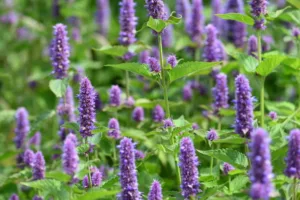
Best Planting Tips:
When planting hyssop, ensure you select a location with full sun exposure. The soil should be well-drained and moderately fertile. Start by preparing the soil, removing any weeds or rocks, and loosening it with a garden fork. Sow the seeds or transplant young seedlings about 12 to 18 inches apart, ensuring they have enough space to grow. Water the plants regularly, especially during dry spells, but be careful not to overwater, as Hyssop prefers slightly drier conditions.
FAQs:
How long does it take for hyssop to flower?
A: Hyssop typically flowers in its second year of growth. It will produce beautiful clusters of small, tubular flowers in shades of blue, pink, or white. The flowers attract bees, butterflies, and other pollinators, making hyssop a beneficial plant for your garden.
Can I use Hyssop for culinary purposes?
A: Yes, hyssop is commonly used as a culinary herb. Its leaves have a strong, minty flavor, adding a delightful touch to various dishes. You can use fresh or dried hyssop leaves to flavor soups, stews, salads, teas, or even make herbal vinegars.
Are there any health benefits associated with hyssop?
A: Hyssop has a long history of medicinal use. It is known for its expectorant and antiseptic properties and has been used to relieve respiratory issues and soothe sore throats. However, it is important to note that hyssop should be used in moderation, and individuals with certain medical conditions should consult a healthcare professional before using it.
In conclusion, hyssop is a versatile herb that not only adds beauty to your garden with its vibrant flowers but also offers culinary and medicinal benefits. By following the ideal growing locations and planting tips, you can enjoy this remarkable herb’s numerous uses and pleasures.
12. Hyacinthoides
Hyacinthoides: A Delicate Spring Flower with Enchanting Beauty
Hyacinthoides, commonly known as Spanish bluebells or wood hyacinths, are captivating spring flowers that bring a burst of color and charm to any garden or landscape. In this brief, we will delve into the ideal growing locations for Hyacinthoides, provide the best planting tips, and answer a frequently asked question about these enchanting blooms.
Ideal Growing Locations:
Hyacinthoides thrive in moderate climates and are native to Western Europe. They prefer partially shaded areas, such as woodland gardens or under deciduous trees, where they can receive dappled sunlight. These hardy plants can adapt to various soil conditions but prefer moist, well-drained soil.
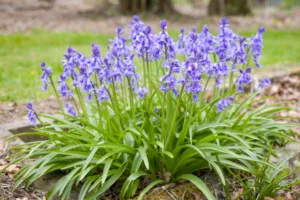
Best Planting Tips:
When planting Hyacinthoides, choose a location that provides the ideal growing conditions mentioned earlier. The optimal time for planting is in the fall, around September or October, before the ground freezes. Prepare the soil by removing any weeds or debris and loosening it with a garden fork. Plant the bulbs 3 to 4 inches deep and space them 4 to 6 inches apart. Water thoroughly after planting to settle the soil and promote root establishment.
FAQs:
How long do Hyacinthoides flowers bloom?
A: Hyacinthoides flowers bloom in the spring, typically from April to May, depending on the region and climate. The blossoms last for several weeks, providing a delightful display of delicate, bell-shaped flowers. They come in shades of blue, purple, and white, creating a stunning carpet of color.
In conclusion, Hyacinthoides, also known as Spanish bluebells or wood hyacinths, are exquisite spring flowers that can transform any garden into a vibrant and enchanting space. By following the ideal growing locations and planting tips, you can enjoy these lovely blooms’ mesmerizing beauty and delicate fragrance.
13. Hemerocallis (Daylily)
Hemerocallis: A Dazzling Perennial with Lush Blooms
Hemerocallis, commonly known as daylilies, are remarkable perennials that captivate with their abundant and vibrant blooms. In this brief, we will explore the ideal growing locations for Hemerocallis, provide the best planting tips, and answer a frequently asked question about these dazzling flowers.
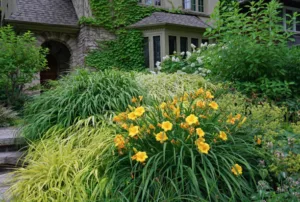
Ideal Growing Locations:
Hemerocallis thrives in various climates and is adaptable to different growing conditions. They prefer full sun exposure but can also tolerate partial shade. These resilient plants can be grown in a wide range of soil types as long as it is well-drained. Hemerocallis are versatile and can be cultivated in gardens, flower beds, or containers.
Best Planting Tips:
To ensure the successful growth of Hemerocallis, it is important to follow these planting tips.
Start by selecting a suitable location with the right amount of sunlight. To improve drainage and fertility, prepare the soil by removing any weeds, rocks, or debris, and amend it with organic matter.
Dig a hole large enough to accommodate the plant’s root system and place the daylily in the hole. Backfill with soil, ensuring that the crown is level with the ground.
Water the plant thoroughly after planting and provide regular watering, especially during dry spells. Mulching around the plant can help retain moisture and suppress weed growth.
FAQs:
How long do Hemerocallis flowers bloom?
A: Hemerocallis flowers are renowned for their extended blooming period. Each individual flower lasts for a single day, but the plants produce multiple flower stalks, allowing for continuous blooms throughout the summer. With proper care, Hemerocallis can provide several weeks of stunning floral displays.
In conclusion, Hemerocallis, or daylilies, are striking perennials that grace gardens with their lush and abundant blooms.
By selecting an ideal growing location and following the best planting tips, you can enjoy the dazzling display of Hemerocallis flowers for an extended period.
Their versatility and resilience make them a fantastic choice for garden enthusiasts seeking vibrant and long-lasting floral beauty.
14. Hieracium (Hawkweed)
Hieracium: A Diverse Genus of Wildflowers with Vibrant Beauty
Hieracium, commonly known as hawkweed, is a diverse genus of wildflowers that adds a splash of vibrant color to meadows, gardens, and natural landscapes.
In this brief, we will explore the ideal growing locations for Hieracium, provide the best planting tips, and answer three frequently asked questions about these captivating flowers.

Ideal Growing Locations:
Hieracium species are found in various regions worldwide, from Europe to North America and beyond. They generally prefer full sun exposure, although some species can tolerate partial shade. Hieracium thrives in well-drained soil and is often found in meadows, grasslands, or open woodland areas. They are adapted to diverse climates and can withstand both hot and cold temperatures.
Best Planting Tips:
When planting Hieracium, choosing a location that suits the specific species you are working with is essential. Some Hieracium plants are best grown from seeds, while others are propagated through root divisions or plant divisions.
Follow the recommended planting depth and spacing for your particular species. Provide adequate watering during establishment, and ensure the soil is well-drained to prevent waterlogging.
Mulching can help conserve moisture and suppress weed growth around the plants.
FAQs:
Do Hieracium flowers attract pollinators?
A: Yes, Hieracium flowers are known to attract various pollinators, including bees, butterflies, and other insects. The bright and showy flowers produce nectar, which entices these beneficial creatures to visit and aid in pollination, contributing to the ecological balance of your garden or landscape.
Are all Hieracium species invasive?
A: While some Hieracium species have become invasive in certain regions, it is important to note that not all species exhibit invasive tendencies. Some species are well-behaved and can be cultivated without concern. However, it is advisable to research and choose native or non-invasive species when considering Hieracium for your garden or landscape.
Can Hieracium be grown in containers?
A: Certain Hieracium species can be grown in containers or pots. Choose smaller or more compact varieties that are better suited to container gardening. Ensure the containers have adequate drainage and use a well-draining potting mix. Regular watering and proper care will help these container-grown Hieracium plants thrive and showcase their vibrant flowers.
In conclusion, Hieracium, or hawkweed, encompasses a diverse genus of wildflowers that contribute to the beauty of natural landscapes and gardens. By selecting the ideal growing locations, following the best planting tips, and considering the specific species, you can enjoy the vibrant and captivating display of Hieracium flowers while supporting pollinators and maintaining a balanced ecosystem.
15. Helenium
Helenium: A Stunning Perennial with Colorful Flowers
Helenium, commonly known as sneezeweed or Helen’s flower, is a breathtaking perennial that adds a splash of vibrant color to gardens and landscapes. In this brief, we will explore the ideal growing locations for Helenium, provide the best planting tips, and answer three frequently asked questions about these captivating flowers.
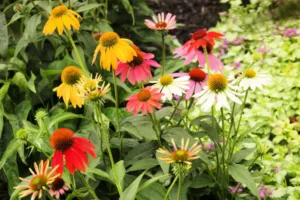
Ideal Growing Locations:
Helenium thrives in full sun to partial shade, making it a versatile plant for various garden settings. It prefers well-drained soil but can tolerate a range of soil types, including clay or sandy soil. Native to North America, Helenium is well-adapted to different climates, from hot summers to cooler regions. It is commonly found in cottage gardens, borders, or wildflower meadows.
Best Planting Tips:
When planting Helenium, select a location that receives at least six hours of direct sunlight per day. Prepare the soil by removing weeds, rocks, and debris. Incorporate organic matter, such as compost, to improve soil fertility and drainage. Dig a hole slightly larger than the plant’s root ball and place the Helenium in the hole. Backfill with soil, ensuring the crown is level with or slightly above the soil surface. Water thoroughly after planting, and provide regular watering during dry periods.
FAQs:
Are Helenium flowers attractive to pollinators?
A: Helenium flowers are highly attractive to pollinators, especially bees and butterflies. The vibrant blooms and nectar-rich flowers act as a magnet, drawing in these important pollinators, which play a crucial role in the reproduction of plants and the overall health of ecosystems.
How long do Helenium flowers bloom?
A: Helenium flowers have a long blooming period, typically from mid-summer to early fall. The showy flowers, resembling daisies or sunflowers, appear in a variety of warm colors, including shades of yellow, orange, and red. Deadheading spent blooms can encourage prolonged flowering and help maintain the plant’s appearance.
Is Helenium a low-maintenance plant?
A: Helenium is generally considered a low-maintenance plant. Once established, it is relatively drought-tolerant and requires minimal care.
Regular watering during dry spells and occasional fertilization with a balanced, slow-release fertilizer can promote healthy growth and abundant blooms.
Removing faded flowers and dividing the plant every few years can help maintain its vigor.
In conclusion, Helenium is a stunning perennial with colorful flowers that bring vibrancy to gardens and landscapes.
By selecting the ideal growing locations, following the best planting tips, and considering its attractiveness to pollinators, you can enjoy the beauty and charm of Helenium while supporting the health of your garden ecosystem.
This low-maintenance plant will reward you with a spectacular display of blooms throughout the summer and early fall.
Blossoming Harmony: Embrace the Captivating Symphony of 15 Flowers Starting With H
In conclusion, Harmonious Blooms: Exploring the Captivating World of 15 Flowers Starting With H has taken us on a journey through the enchanting realm of floral beauty.
We have discovered these captivating flowers’ vibrant colors, delicate fragrances, and ideal growing conditions.
From the serene presence of Hibiscus to the elegance of Hydrangeas, and the mesmerizing allure of Hellebores, each flower offers its unique charm.
We have learned about their symbolism, their ability to uplift our spirits, and the joy they bring to our lives. We invite tranquility, beauty, and emotional well-being by incorporating these harmonious blooms into our gardens and landscapes.
So, whether you choose to embrace the elegance of Heather, the grace of Hollyhocks, or the fragrance of Hyacinths, each flower starting with H carries its own enchantment.
Let us continue to cultivate these breathtaking blossoms, forging a deeper connection with the natural world and allowing their beauty to inspire us.
So go ahead, create your own floral oasis and let the harmonious blooms of these magnificent flowers, starting with H, fill your surroundings with their captivating presence.

Hi there, I’m Mark Apletree, a gardening enthusiast with a passion for gardening, and gardening tools. I’ll be your go-to guide for all things related to gardening. The purpose of this website is to assist you in selecting the most suitable garden gear that meets your specific requirements.
See All Posts
